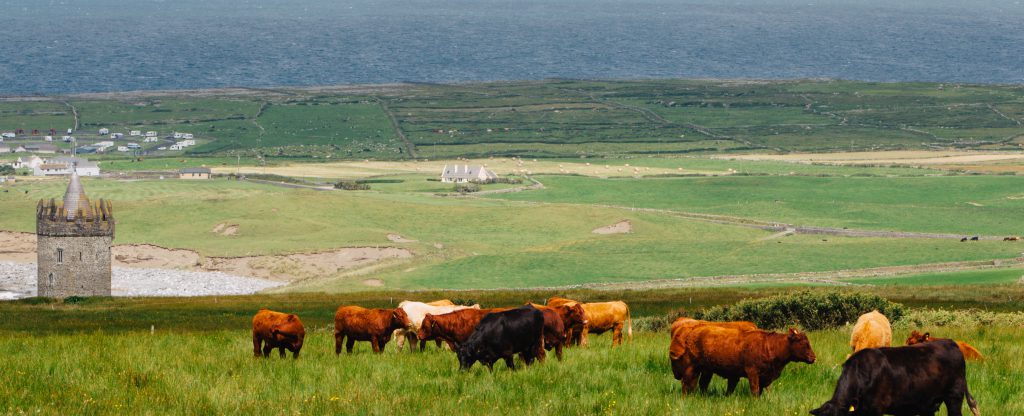We all know that beef is a diverse meat, suitable to a variety of cuisines and cooking methods. Interestingly the beef cattle types themselves are just as diverse. As well as the difference between beef and dairy, there are many terms within these groups; heifer, bull and steer among them, and over 250 breeds of cow around the world. Find out more about some of the most popular breeds below.
ABERDEEN ANGUS
Origins: The Angus originates from Scotland, but is now considered to be the dominant breed in Ireland. This is also the case in several countries further afield, including the USA, Canada, Argentina, New Zealand and Australia.
Features: This popularity is easily explained. Hardy and adaptable, Angus cows are docile and have exceptional fat marbling, which produces extremely tender and tasty meat.
Fact: First exported to America by a Kansas rancher in 1873, Angus cows were crossed with the Texas longhorn breed. This subsequently helped add winter hardiness to their list of qualities.
DEXTER
Origins: Dexter cattle originate in South West Ireland, where they would have been kept by small landowners, before being exported to the US in the early 1900s.
Features: Dexter cattle descended from the predominately black cattle of the early Celts. In turn, Dexter cattle have the same inky colouring and are one of the smallest known breeds, standing at just one metre high.
Fact: Despite their diminutive stature, Dexter cows are incredibly efficient in terms of both their milk and beef production.
HEREFORD
Origins: The breed was developed in England in the 1700s, supposedly to fulfil the expanding food market created by the industrial revolution.
Features: Known for their longevity, the Hereford also has a docile nature, leading to low stress levels and high quality meat.
Fact: Historically, Herefords were much larger than they are today. In the 1700s and 1800s there are records of animals weighing over 3,000 pounds.
GALLOWAY
Origins: Taking its name from the Gauls, the first inhabitants of south-west Scotland, the breed originated in the area in the 17th century.
Features: Hornless with dark, wavy coats, the Galloway has a good level of marbling, leading to high-quality, flavoursome meat.
Fact: The breed number fewer than 10,000 cattle in the world, and is classified as ‘rare’ in the United States.
WAGYU
Origins: In Japan, where cattle was first introduced in the second century as a means of providing power for the cultivation of rice.
Features: Although many different breeds come under the ‘wagyu’ term, cattle from the Kobe region provide the standard in terms of texture and flavour. Research in breeding and feeing have led to Kobe beef gaining popularity in terms of its flavour and texture.
Fact: There is some confusion about Wagyu as a term, but it is simply a blanket term for ‘Japanese Cattle’: ‘Wa’ meaning Japanese and ‘gyu’ meaning cattle.
SCOTTISH HIGHLAND
Origins: It will come as no surprise that the origin of this breed is in the wilds of Scotland. They are descendants of a longhorn breed brought to Britain by Neolithic farmers as far back as the second millennium BC.
Features: The Scottish Highland cattle possesses a double coat of hair which provides highly efficient insulation. As a result their meat tends to be leaner than most beef due to a lesser need for fat.
Fact: Their tolerance to cold has been described as being on par with arctic-dwelling animals such as reindeer and caribou.
PIEDMONTESE
Origins: The breed originated in Piedmont in North West Italy around 25,000 years ago, making the it one of the oldest breeds of cattle in the world.
Features: Due to a genetic abnormality, Piedmontese cows develop muscle at an unrestricted rate. They are also much more hardy and disease resistant that most beef cattle.
Fact: Piedmontese are used for both beef and dairy farming. As a result, their milk is used in most Italian cheeses.


